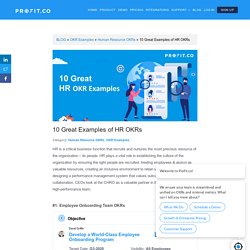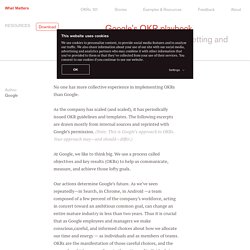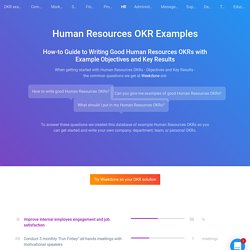

10 Great Examples of HR OKRs. HR is a critical business function that recruits and nurtures the most precious resource of the organization – its people.

HR plays a vital role in establishing the culture of the organization by ensuring the right people are recruited, treating employees & alumni as valuable resources, creating an inclusive environment to retain valuable diverse talent, designing a performance management system that values outcome, teamwork, and collaboration. CEOs look at the CHRO as a valuable partner in their quest to create a high-performance team. #1: Employee Onboarding Team OKRs Objective David Griffin Develop a World-Class Employee Onboarding Program Visibility: All Employees Key Results Improve onboarding employee satisfaction score after onboarding from 75% to 95% Onboarding Employee Satisfaction Score Reduce new hire 30-days failure rate from 10% to 5% Annual-2020 New Hire 30-Days Failure Rate Productivity Assessment Score #2: Employee Wellness Team OKRs Establish a Wonderful Employee Wellness Program.
La méthode OKR : Objectives and Key Results. Née dans les années 50 aux Etats-Unis, la méthode OKR a depuis longtemps fait ses preuves dans de nombreuses entreprises de la Silicon Valley.

Mais en quoi consiste-t-elle ? Comment l’utiliser et pourquoi ? What Matters: OKR vs. Scrum: What's the difference? What Matters: OKR Google playbook: Examples & templates. No one has more collective experience in implementing OKRs than Google.

As the company has scaled (and scaled), it has periodically issued OKR guidelines and templates. The following excerpts are drawn mostly from internal sources and reprinted with Google’s permission. (Note: This is Google’s approach to OKRs. Your approach may—and should—differ.) At Google, we like to think big. Our actions determine Google’s future. We use OKRs to plan what people are going to produce,track their progress vs. plan, and coordinate priorities and milestones between people and teams. OKRs are big, not incremental — we don’t expect to hit all of them. 0.0–0.3 is red 0.4–0.6 is yellow 0.7–1.0 is green Writing Effective OKRs Poorly done/managed OKRs are a waste of time, an empty management gesture.
Writing good OKRs isn’t easy, but it’s not impossible, either. Objectives are the “Whats.” Key Results are the “Hows.” Cross-team OKRs Many important projects at Google require contribution from different groups. Weekdone says… When getting started with Human Resources OKRs - Objectives and Key Results - the common questions we get at Weekdone are: How to write good Human Resources OKRs?

Can you give me examples of good Human Resources OKRs? What should I put in my Human Resources OKRs? To answer these questions we created this database of example Human Resources OKRs so you can get started and write your own company, department, team, or personal OKRs. When getting started with Human Resources OKRs - Objectives and Key Results - the common questions we get at Weekdone are: How to write good Human Resources OKRs? To answer these questions we created this database of example Human Resources OKRs so you can get started and write your own company, department, team, or personal OKRs. Guide: Set goals with OKRs. Studies have shown that committing to a goal can help improve employee performance.

But more specifically, research reveals that setting challenging and specific goals can further enhance employee engagement in attaining those goals. Google often uses “Objectives and Key Results” (OKRs) to try to set ambitious goals and track progress. OKRs at a glance: Objectives are ambitious and may feel somewhat uncomfortableKey results are measurable and should be easy to grade with a number (Google uses a scale of 0 – 1.0)OKRs are public so that everyone in the organization can see what others are working onThe “sweet spot” for an OKR grade is 60% – 70%; if someone consistently fully attains their objectives, their OKRs aren’t ambitious enough and they need to think biggerLow grades should be viewed as data to help refine the next OKRsOKRs are not synonymous with employee evaluationsOKRs are not a shared to-do list.